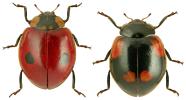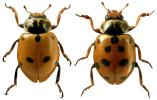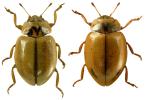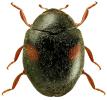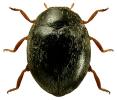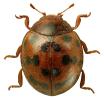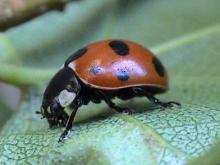Images:
A very distinctive family, with 53 species listed as British on the 2012 checklist. However, this includes two species introduced as biocontrol agents in greenhouses with occasional short-lived colonies outside (Rodolia cardinalis (Mulsant), Cryptolaemus montrouzeri Mulsant) and five species which are thought to be either now extinct in Britain (Vibidia duodecimguttata (Poda), Nephus bisignatus (Boheman)) or occasional adventives (Coccinula quattuordecimpustulata (L.), Scymnus jakowlewi Weise, Scymnus rubromaculatus (Goeze)). Hippodamia tredecimpunctata (L.) is another species which was thought to be extinct in Britain, but small numbers of immigrant individuals have been seen scattered along the south coast of England since 2000, culminating in a larva and four adults found in Devon in 2011. Several other species are regularly imported on produce, particularly grapes.
The family is generally divided into two groups, mainly on size: the ladybirds (subfamilies Chilocorinae, Coccinellinae and Epilachninae) which are longer than 3mm and mostly smooth, hairless, brightly-coloured hemispherical beetles with contrasting patterns of spots or stripes, and the inconspicuous coccinellids (subfamily Coccidulinae, plus Platynaspis luteorubra (Goeze) (Epilachninae)), which are 1-3mm long and generally hairy and dull black or red-brown in colour, usually without clear spots. The short semi-clubbed antennae and triangular axe-shaped palps at once distinguish even these smaller species as ladybirds when examined, however. Most species are predatory on smaller invertebrates, particularly aphids but some specialise in eating scale insects (Chilocorus spp. and Exochomus quadripustulatus (L.)), mildew (Halyzia sedecimguttata (L.)), vegetation (Henosepilachna argus (Geoffory in Fourcroy) and Subcoccinella vigintiquattuorpunctata (L.)), and mites (Stethorus punctillum (Weise)).
The family includes several species which are relatively recent arrivals in Britain. The most famous of these is undoubtedly the harlequin ladybird, Harmonia axyridis (Pallas), a habitat and dietary generalist released as a biocontrol agent which became established in 2004, but Rhyzobius lophanthae (Blaisdell), Rhyzobius chrysomeloides (Herbst) and H. argus have all also become established in Britain since 1997. Many Coccinellidae appear to be climate-restricted in Britain and ongoing climate change may well favour the establishment of more European species in the near future.
